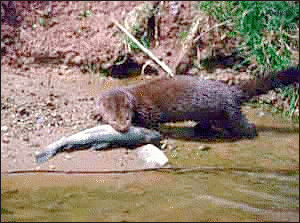Minks are semi-aquatic members of the weasel family that live in Connecticut. Their bodies are long and slender and their legs short. They have dark brown to black fur and a furry tail 6 1/2 to 7 1/2 inches long. They sometimes have a white on their chin or throat. Their feet are slightly webbed. They are larger than weasels and smaller than fishers, weighing 1 1/2 to 3 1/2 lbs.
Minks range through the continental US except for the southwestern quarter, and range through Canada and Alaska. Mink habitat includes water and they are found along rivers, streams, lakes, ponds and in marshes. They are primarily nocturnal and are active year-round.
Minks are carnivorous. Their favorite prey are muskrats, but they hunt other small animals such as mice, voles, squirrels, rabbits, chipmunks, fish, frogs, snakes and birds. They will occassionaly take poultry. Mink cache extra meat in their den.
Mink in New England mate in late February through early March. Mating is preceded by a rough courtship fight. Males may travel far seeking females. 1 to 10 babies are born in April or May. Minks are not monogamous and females care for the young.
Minks are solitary except when a female is raising her young. They use dens near water and move often. Dens can be located in tree cavities, rock or brush piles, or in old muskrat or beaver dens. They can dig their own dens as well.
Minks spend alot of time in the water. Their fur is oily and waterproof. They can dive up to 16 feet and can swim underwater for distances of 50 ft. They can swim under ice. Mink produce a pungent musk that is as smelly as a skunk's and is used to mark territory and for defense. A threatened mink will hiss, snarl and discharge the stinky musk, but they cannot spray it at attackers. A contented mink will make a purring sound.
Neat Fact
Even though the use of fur in fashion is declining, everyone has heard of the mink fur coat as a symbol of glamor. Now minks are farmed for their fur more often than trapped, and even selectively bred for color variations. Fur farming is a very controversial practice.
American Mink were transported to Scotland in the 1950s (for fur farming). They escaped into the wild and are now an invasive species there. Thousands now roam the countryside having a damaging impact on Scotland's local wildlife. Scotland's European water-vole has been particularly hard-hit, nearly erradicated in many places. The character of "Ratty" in the beloved book the "Wind in the Willows" was a water-vole, and the Scots are fond of them. In early 2011 an ambitious program to remove the American Mink from Scotland through trapping and hunting was begun. This is a good example of how an animal that fits well into the ecosystem of its home range can often run rampant when it is relocated somewhere else.

